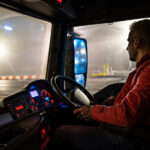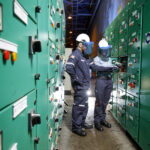Scania gets heavy with e-mobility
Scania gets heavy with e-mobility
Scania is already blazing the e-mobility trail in South Africa. Now it’s doing the same in Sweden’s gruelling mining industry.
If there is one word on the lips of transport operators all over the world, it is “e-mobility”, and electrification marks a new era for the transport industry. “Scania has already passed many milestones on our electrification roadmap and we are confident we can offer our customers a credible alternative to vehicles with internal combustion engines,” asserts Mark Templeton, sustainability manager at Scania Southern Africa.
The company isn’t just paying lip service to the concept of e-mobility; it is already leading the charge towards electrification in partnership with South African retailer Shoprite, which is the first retailer to pilot a heavy-duty electric truck. The battery electric vehicle (BEV) supplied by Scania began operating for Shoprite in November 2022. With a range of around 350 km, the truck produces zero carbon emissions and is recharged using renewable energy generated by Shoprite’s existing solar installations.
But Scania isn’t only exploring e-mobility when it comes to distribution trucks. In Sweden, the manufacturer has supplied an electric heavy tipper to Luossavaara-Kiirunavaara AB (LKAB), a massive company that has mines and processing plants in Kiruna, Malmberget, and Svappavaara.
LKAB’s iron ore is mined both above and below ground. The vast majority of mining takes place several hundred metres underground in the mines in Kiirunavaara (Kiruna) and Malmberget (Gällivare), which are the world’s two largest underground iron ore mines. In Svappavaara, the ore is mined in the Leveäniemi surface mine.
In Kiruna, the iron ore mined every day is enough to build the equivalent of 6.5 Eiffel Towers, while in Gällivare and Svappavaara, LKAB can deliver raw materials for building 4.5 and two copies respectively of the famous French tower.
The Scania tipper operates at the mine in Malmberget. With an annual production capacity of over five million tonnes of iron ore, the mine contains 20 orebodies (of which 10 are currently being mined) spread over an underground area of about 5 x 2.5 km. Mining began in 1892 and, since then, over 350 Megatons of ore have been extricated. LKAB employs around 1 000 people at Malmberget, 900 of whom work in mining, processing, and administration.
The underground mining environment is especially demanding, so the Scania tipper is being tested to its very limits. The first of its kind in the mining industry, the electric heavy tipper transports residual products and, including load, has a total weight of 49 tonnes.
“This electric truck is part of an ambition to set a new standard for sustainable mining, where fossil-free is used all the way. We are shifting our fleet away from fossil diesel and as we test the capacity of battery-powered electric vehicles, decisions taken with respect to the choice of trucks must not only contribute to higher productivity but also, above all, a more sustainable mine and a safer work environment,” says Peter Gustavsson, project manager at LKAB.
Scania and LKAB both operate in industries currently undergoing significant shifts towards improved sustainability. LKAB is striving to become one of the most sustainable mining companies in the world. In fact, it is working towards zero carbon dioxide emissions from its own processes and products by 2045. It is therefore apt that these two well-established industrial companies have joined forces to operate electric vehicles in LKAB’s mines – a step towards the future and sustainable transport for this industry.
Published by
Focus on Transport
focusmagsa




